A Full Parallel Event Driven Readout Technique for Area Array SPAD FLIM Image Sensors
Abstract
:1. Introduction
2. TCSPC FLIM Imaging System
2.1. Circuits Architecture
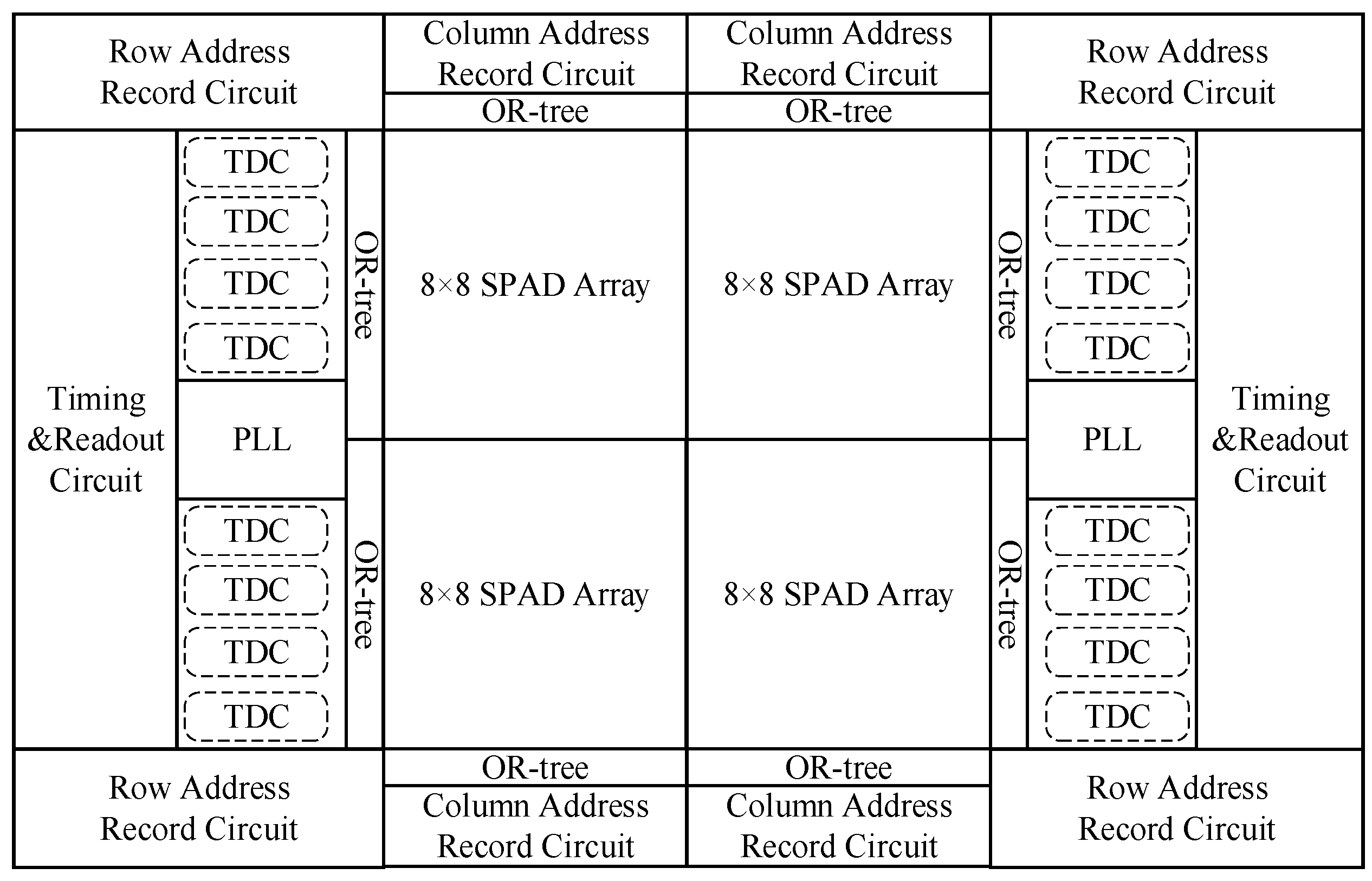
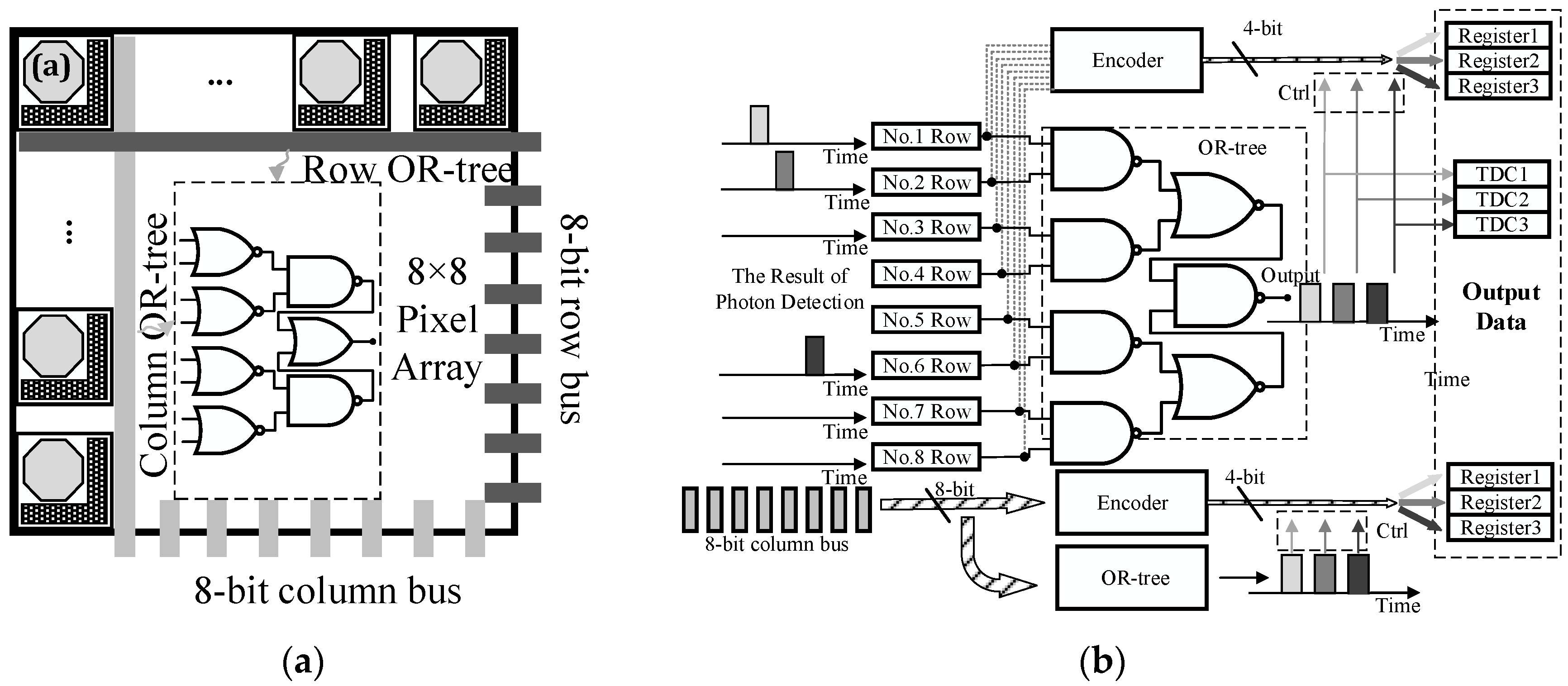
2.2. SPAD Pixel Array
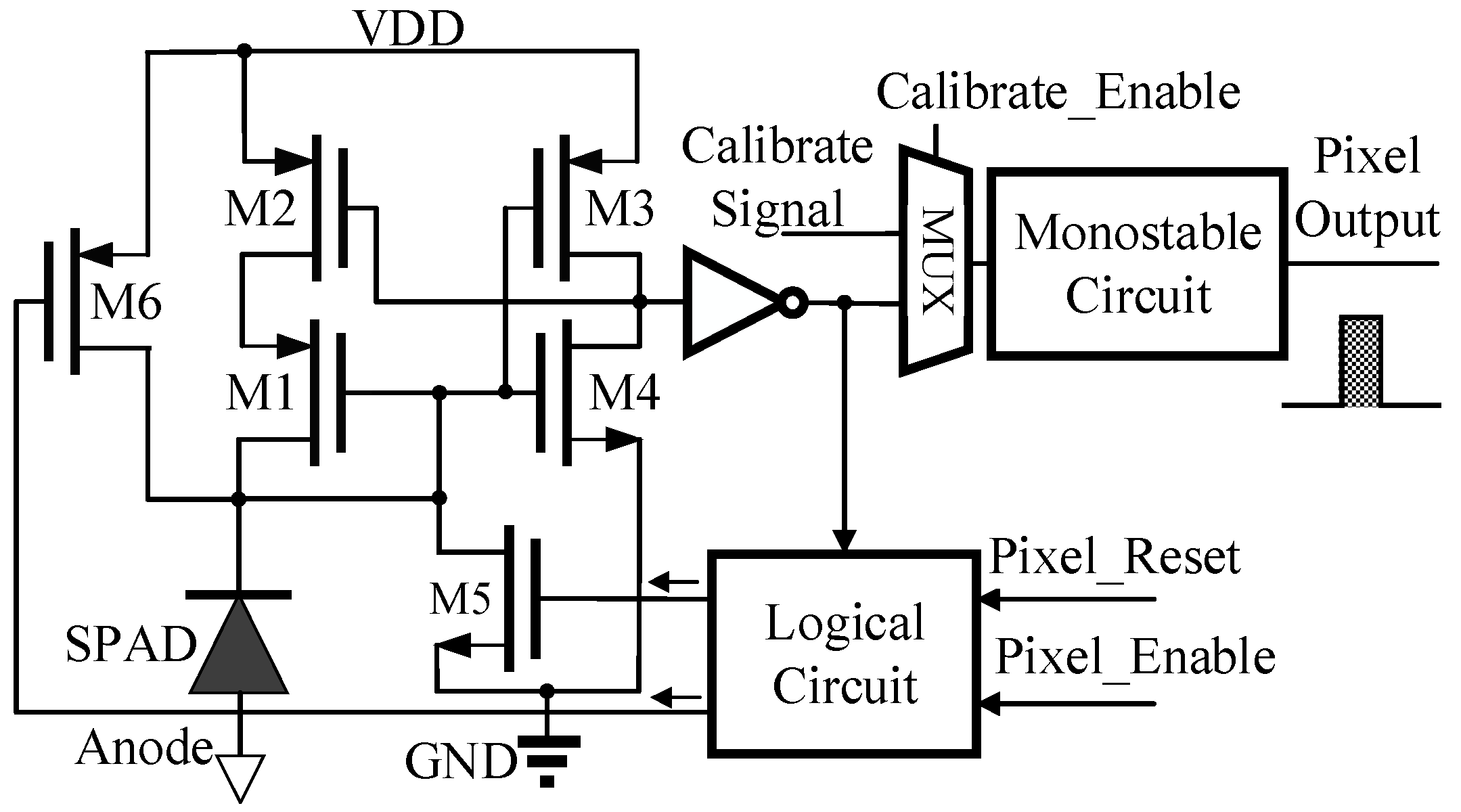
2.3. Time-to-Digital Converters Array

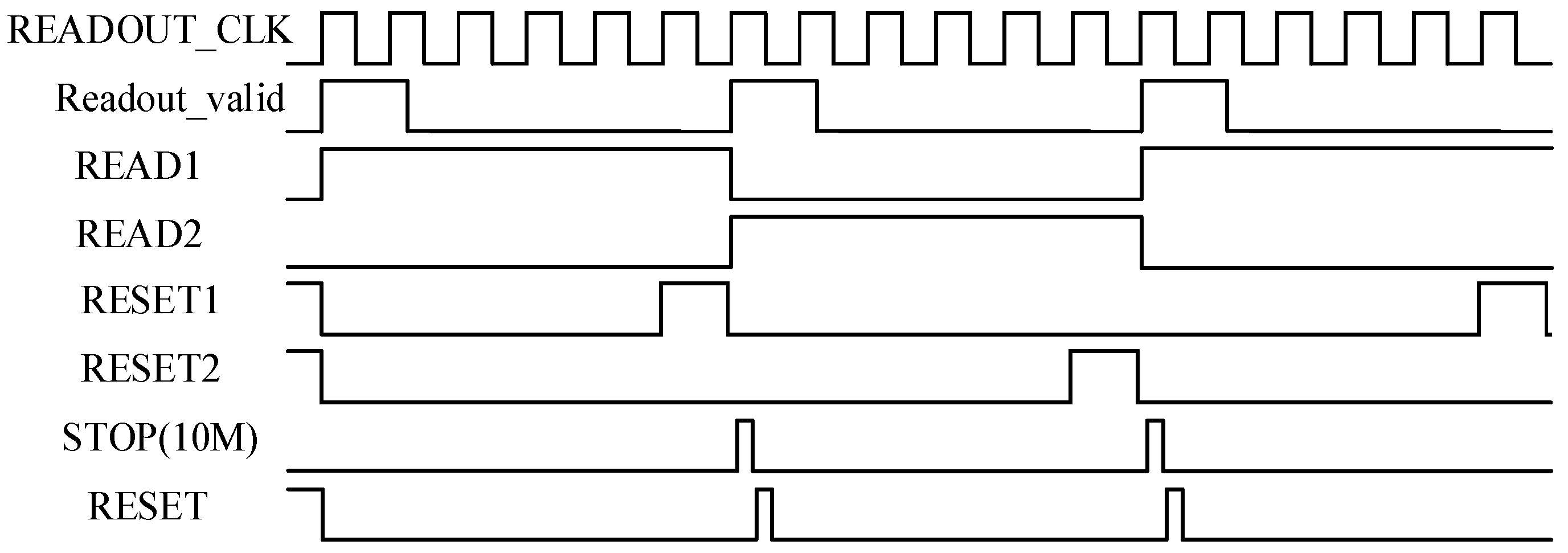
3. Fluorescence Lifetime Imaging Error Analysis for the Proposed Readout Method
3.1. Pile-Up Effect during Events Readout
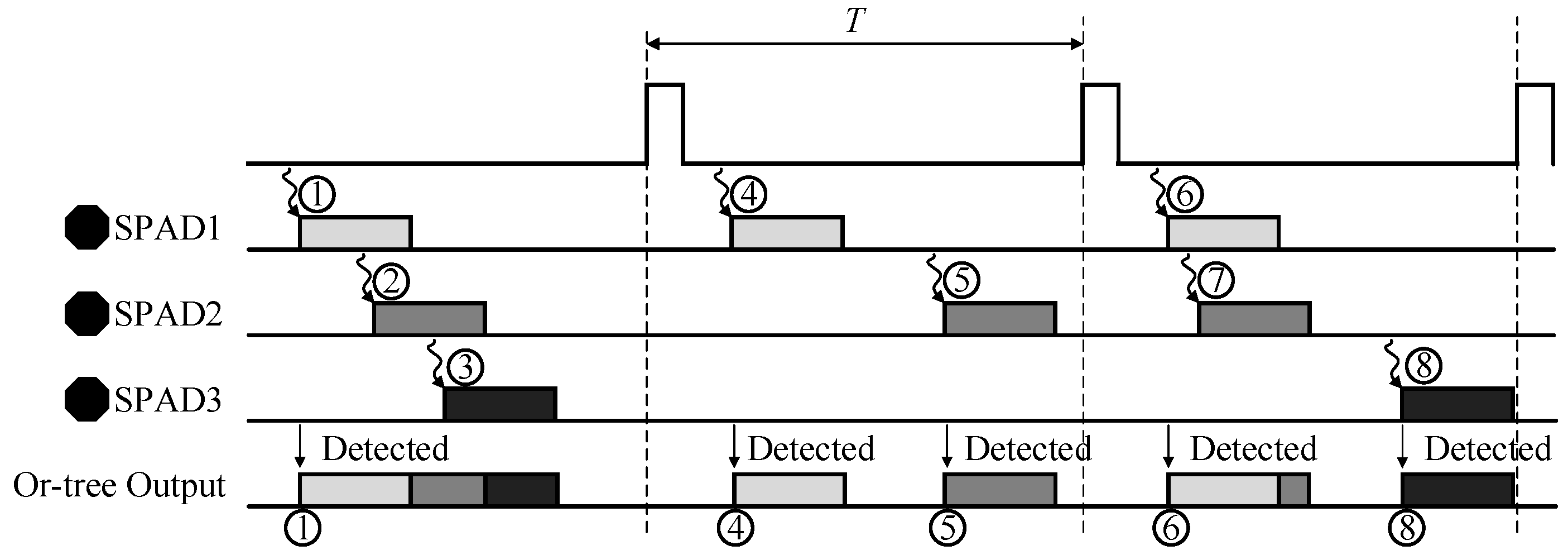

3.2. Fluorescence Lifetime Imaging Algorithm


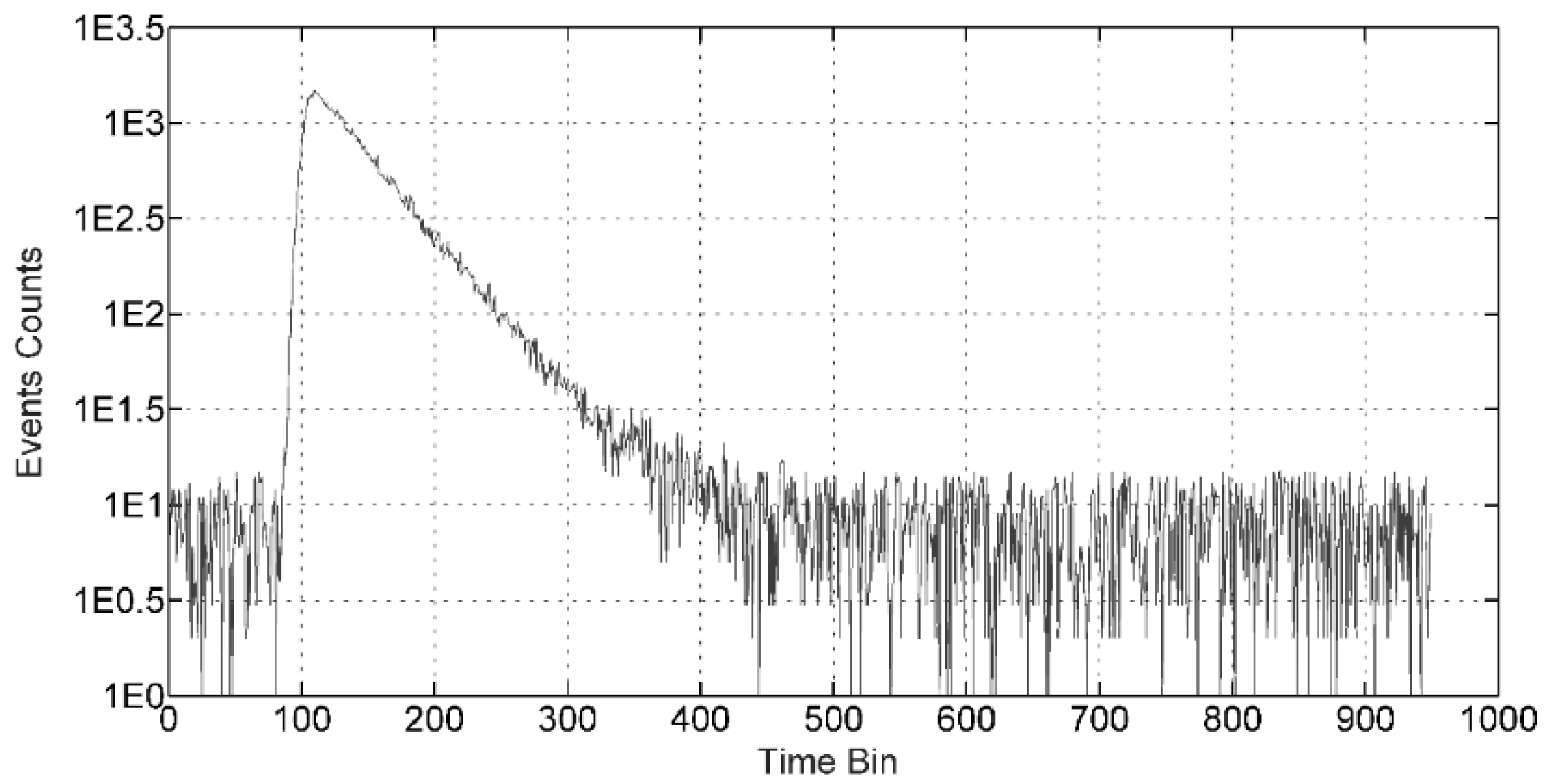
4. Simulation Results of Circuits
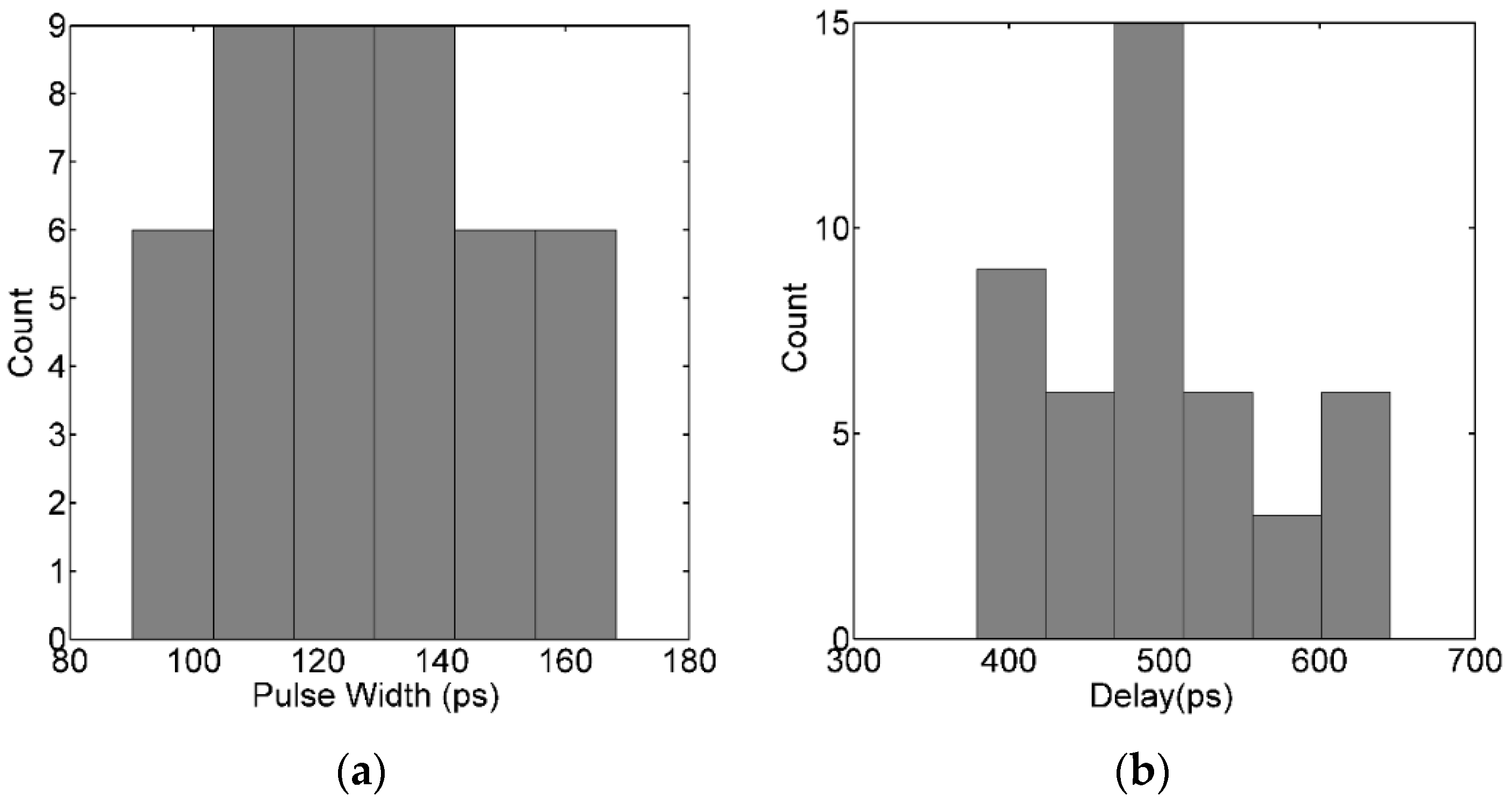
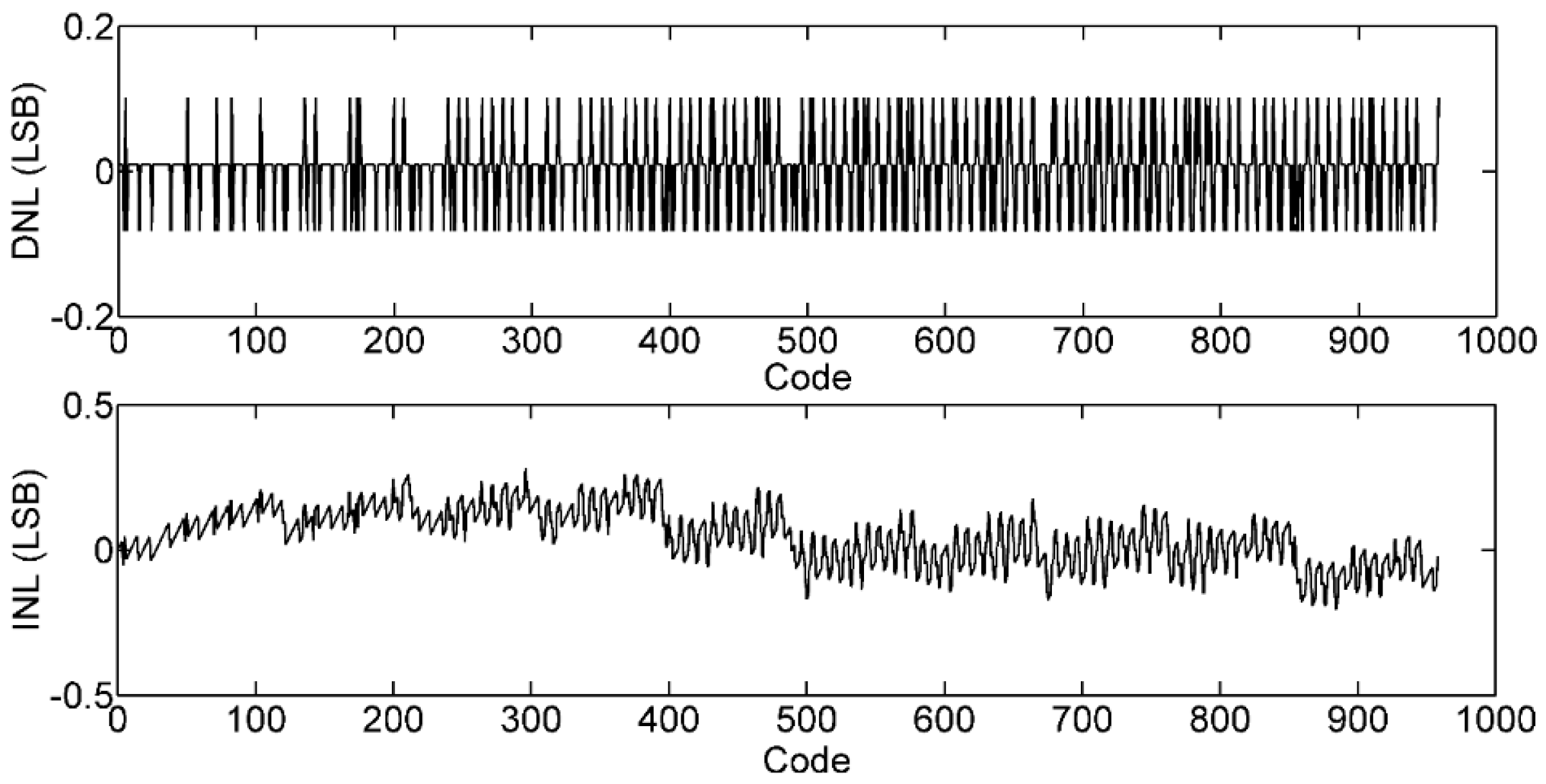
| MLE | CMM | LSM | |
|---|---|---|---|
| Actual Lifetime [ns] | 10.5 | 10.5 | 10.5 |
| Estimated Lifetime [ns] | 10.537 | 10.53 | 10.589 |
| Average Error [%] | 0.35 | 0.28 | 0.84 |
| Standard Deviation@(10 ms)[ps] | 413 | 410 | 672 |
| Standard Deviation@(100 ms)[ps] | 34.9 | 34.6 | 115 |
| Standard Deviation@(2 s)[ps] | 23 | 22.9 | 46 |
| Imaging FoM@(2 s) | 241 | 279 | 105 |
| MLE | CMM | LSM | |
|---|---|---|---|
| Actual Lifetime [ns] | 14 | 14 | 14 |
| Estimated Lifetime [ns] | 14.03 | 13.95 | 14.24 |
| Average Error [%] | 0.24 | 0.28 | 1.69 |
| Standard Deviation@(10 ms) [ps] | 442 | 423 | 487 |
| Standard Deviation@(100 ms) [ps] | 119 | 114 | 158 |
| Standard Deviation@(2 s) [ps] | 36.9 | 35.3 | 45 |
| Imaging FoM@(2 s) | 280 | 242 | 59 |

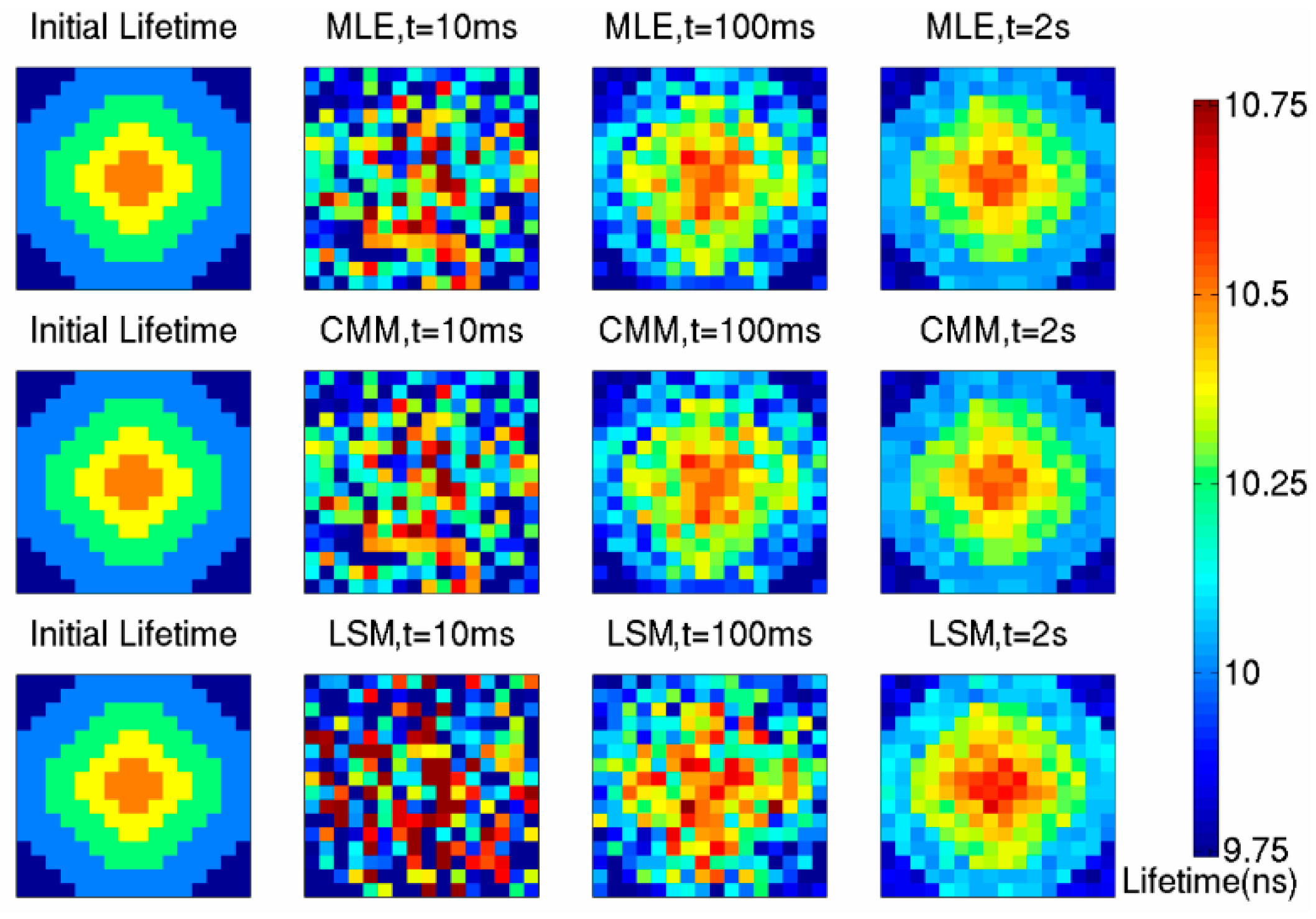
| Parameters | Reference 14 | Reference 18 | Reference 15 | Reference 19 | This Work |
|---|---|---|---|---|---|
| Resolution | 160 × 128 | 32 × 32 | 64 × 64 | 64 × 64 | 16 × 16 |
| CMOS Technology | 0.13 um | 0.13 um | 0.35 um | 0.13 um | 0.13 um |
| Fill Factor [%] | 1 | 2 | 0.93 | 0.77 | 5.7 |
| Number of TDC | 1/1 | 1/1 | 4096/1 | 1/1 | 64/4 |
| LSB of TDC [ps] | 55 | 119 | 350 | 62.5 | 97 |
| Laser Pulse Rate [MHz] | 40 | 40 | N/A | 20 | 10 |
| Sampling Rate [Sps] | 50 k | 1 M | 718 | 20 M | 10 M |
| Lifetime frame rate [fps] | 0.08 | 1.8 | 3.9 | 100 | 100 |
| @ histogram photons | @ ≈ 30,0000 | @ ≈ 22,0000 | @ ≈ 200 | @ ≈ 600 | @ = 1000 |
| Bandwidth [bps] | 51.2 G | 10.24 G | N/A | 42 G | 720 M |
| Power [W] | 550 m | 90 m* | 1.4 | 8.79 | 15 m** |
| Chip FoM [pJ/(sample·pixel)] | 537 | 87 | 476 k | 107 | 5.86 |
5. Conclusions
Acknowledgments
Author Contributions
Conflicts of Interest
References
- Siegel, J.; Elson, D.S.; Webb, S.E.D.; Lee, K.C.B.; Vlandas, A.; Gambaruto, G.L.; Lévêque-Fort, S.; Lever, M.J.; Tadrous, P.J.; Stamp, G.W.H.; et al. Studying biological tissue with fluorescence lifetime imaging: Microscopy, endoscopy, and complex decay profiles. Appl. Opt. 2003, 42, 2995–3004. [Google Scholar] [CrossRef] [PubMed]
- Fatakdawala, H.; Poti, S.; Zhou, F.; Sun, Y.; Bec, J.; Liu, J.; Yankelevich, D.R.; Tinling, S.P.; Gandour-Edwards, R.F.; Farwell, D.G.; et al. Multimodal in vivo imaging of oral cancer using fluorescence lifetime, photoacoustic and ultrasound techniques. Biomed. Opt. Express. 2013, 4, 1724–1741. [Google Scholar] [CrossRef] [PubMed]
- Cubeddu, R.; Comelli, D.; D’Andrea, C.; Taroni, P.; Valentini, G. Time-resolved fluorescence imaging in biology and medicine. J. Phys. D Appl. Phys. 2002, 35, R61–R76. [Google Scholar] [CrossRef]
- Pawley, J.B. Handbook of Biological Confocal Microscopy; Springer: New York, NY, USA, 1995; pp. 516–534. [Google Scholar]
- Mosconi, D.; Stoppa, D.; Pancheri, L.; Gonzo, L.; Simoni, A. CMOS Single Photon Avalanche Diode Array for Time-Resolved Fluorescence Detection. In Proceedings of the 32nd European Solid-State Circuits Conference (ESSCIRC), Montreaux, Switzerland, 19–21 September 2006; pp. 564–567.
- Li, D.; Arlt, J.; Richardson, J.; Walker, R.; Buts, A.; Stoppa, D.; Charbon, E.; Henderson, R. Real-time fluorescence lifetime imaging system with a 32 × 32 0.13 μm CMOS low dark-count single-photon avalanche diode array. Opt. Express. 2010, 18, 10257–10269. [Google Scholar] [CrossRef] [PubMed]
- Savuskan, V.; Gal, L.; Cristea, D.; Javitt, M.; Feiningstein, A.; Leitner, T.; Nemirovsky, Y. Single photon avalanche diode collection efficiency enhancement via peripheral well controlled field. IEEE Trans. Electron Dev. 2015, 62, 1939–1945. [Google Scholar] [CrossRef]
- Cova, S.; Ghioni, M.; Lacaita, A.; Samori, C.; Zappa, F. Avalanche photodiodes and quenching circuits for single-photon detection. Appl. Opt. 1996, 35, 1956–1976. [Google Scholar] [CrossRef] [PubMed]
- Richardson, J.A.; Webster, E.A.G.; Grant, L.A.; Henderson, R.K. Scaleable Single-Photon Avalanche Diode Structures in Nanometer CMOS Technology. IEEE Trans. Electron Dev. 2011, 58, 2028–2035. [Google Scholar] [CrossRef]
- Palubiak, D.P.; Deen, M.J. CMOS SPADs: Design Issues and Research Challenges for Detectors, Circuits, and Arrays. IEEE J. Sel. Top. Quantum Electron. 2014, 20, 409–426. [Google Scholar] [CrossRef]
- Stoppa, D.; Mosconi, D.; Pancheri, L.; Gonzo, L. Single-Photon Avalanche Diode CMOS Sensor for Time-Resolved Fluorescence Measurements. IEEE Sens. J. 2009, 9, 1084–1090. [Google Scholar] [CrossRef]
- Li, D.D.; Ameerbeg, S.M.; Arlt, J.; Tyndall, D.; Walker, R.J.; Matthews, D.R. Time-Domain Fluorescence Lifetime Imaging Techniques Suitable for Solid-State Imaging Sensor Arrays. Sensors 2012, 12, 5650–5669. [Google Scholar] [CrossRef] [PubMed]
- Vitali, M.; Bronzi, D.; Krmpot, A.J.; Nikolić, S.N.; Schmitt, F.J.; Junghans, C.; Tisa, S.; Friedrich, T.; Vukojević, V.; Terenius, L.; et al. A Single-Photon Avalanche Camera for Fluorescence Lifetime Imaging Microscopy and Correlation Spectroscopy. IEEE J. Sel. Top. Quantum Electron. 2014, 20, 1–10. [Google Scholar] [CrossRef]
- Veerappan, C.; Richardson, J.; Walker, R.; Li, D.D.U.; Fishburn, M.W.; Maruyama, Y.; Stoppa, D.; Borghetti, F.; Gersbach, M.; Henderson, R.K.; et al. A 160 × 128 single-photon image sensor with on-pixel 55 ps 10 b time-to-digital converter. In Proceedings of the IEEE International Solid-state Circuits Conference (ISSCC), San Francisco, CA, USA, 20–24 February 2011; pp. 312–314.
- Schwartz, D.E.; Charbon, E.; Shepard, K.L. A Single-Photon Avalanche Diode Array for Fluorescence Lifetime Imaging Microscopy. IEEE J. Solid State Circuits 2008, 43, 2546–2557. [Google Scholar] [CrossRef] [PubMed]
- Stoppa, D.; Borghetti, F.; Richardson, J.; Walker, R.; Grant, L.; Henderson, R.K.; Gersbach, M.; Charbon, E. A 32 × 32-pixel array with in-pixel photon counting and arrival time measurement in the analog domain. In Proceedings of the European Solid-state Circuits Conference (ESSCIRC), Athens, Greece, 14–18 February 2009; pp. 204–207.
- Niclass, C.; Favi, C.; Kluter, T.; Gersbach, M.; Charbon, E. A 128 × 128 single-photon image sensor with column-level 10-bit timeto-digital converter array. IEEE J. Solid State Circuits 2008, 43, 2977–2989. [Google Scholar] [CrossRef]
- Gersbach, M.; Maruyama, Y.; Trimananda, R.; Fishburn, M.W.; Stoppa, D.; Richardson, J.A.; Walker, R.; Henderson, R.; Charbon, E. A Time-Resolved, Low-Noise Single-Photon Image Sensor Fabricated in Deep-Submicron CMOS Technology. IEEE J. Solid State Circuits 2012, 47, 1394–1407. [Google Scholar] [CrossRef]
- Field, R.M.; Realov, S.; Shepard, K.L. A 100 fps, Time-Correlated Single-Photon-Counting-Based Fluorescence-Lifetime Imager in 130 nm CMOS. IEEE J. Solid State Circuits 2014, 49, 867–880. [Google Scholar] [CrossRef]
- Homulle, H. Development of a Multichannel TCSPC System in a Spartan 6 FPGA. Ph.D. Thesis, Technical University of Delft, Delft, Netherland, 2014. [Google Scholar]
- Dutton, N.A.W.; Gnecchi, S.; Parmrsan, L.; Holmes, A.J.; Rae, B.; Grant, L.A.; Henderson, R.K. A Time-Correlated Single-Photon Counting Sensor with 14 GS/s Histogramming Time-to-Digital Converter. In Proceedings of the IEEE International Solid-state Circuits Conference (ISSCC), San Francisco, CA, USA, 22–26 February 2015; pp. 1–3.
- Villa, F.; Lussana, R.; Tosi, A.; Zappa, F. High fill-factor 60 × 1 SPAD array with 60 sub-nanosecond integrated TDCs. IEEE Photonic Tech. Lett. 2015, 27, 1261–1264. [Google Scholar] [CrossRef]
- Stipčević, M. Active quenching circuit for single-photon detection with Geiger mode avalanche photodiodes. Appl. Opt. 2009, 48, 1705–1714. [Google Scholar] [CrossRef] [PubMed]
- Tyndall, D.; Rae, B.R.; Li, D.D.U.; Arlt, J.; Johnston, A.; Richardson, J.A.; Henderson, R.K. A High-Throughput Time-Resolved Mini-Silicon Photomultiplier With Embedded Fluorescence Lifetime Estimation in 0.13 μm CMOS. IEEE Trans. Biomed. Circuits Syst. 2012, 6, 562–570. [Google Scholar] [CrossRef] [PubMed]
- Mita, R.; Palumbo, G. High-Speed and Compact Quenching Circuit for Single-Photon Avalanche Diodes. IEEE Trans. Instrum. Meas. 2008, 57, 543–547. [Google Scholar] [CrossRef]
- Arlt, J.; Tyndall, D.; Rae, B.R.; Li, D.D.U.; Richardson, J.A.; Henderson, R.K. A study of pile-up in integrated time-correlated single photon counting system. Rev. Sci. Instrum. 2013, 84, 103105. [Google Scholar] [CrossRef] [PubMed]
- Hall, P.; Sellger, B. Better Estimates of Exponential Decay Parameters. J. Phys. Chem. 1981, 85, 2491–2496. [Google Scholar] [CrossRef]
- Li, D.D.U.; Arlt, J.; Tyndall, D.; Walker, R.; Richardson, J.; Stoppa, D.; Charbon, E.; Henderson, R.K. Video-rate fluorescence lifetime imaging camera with CMOS single-photon avalanche diode arrays and high-speed imaging algorithm. J. Biomed. Opt. 2011, 16. [Google Scholar] [CrossRef] [PubMed]
© 2016 by the authors; licensee MDPI, Basel, Switzerland. This article is an open access article distributed under the terms and conditions of the Creative Commons by Attribution (CC-BY) license (http://creativecommons.org/licenses/by/4.0/).
Share and Cite
Nie, K.; Wang, X.; Qiao, J.; Xu, J. A Full Parallel Event Driven Readout Technique for Area Array SPAD FLIM Image Sensors. Sensors 2016, 16, 160. https://doi.org/10.3390/s16020160
Nie K, Wang X, Qiao J, Xu J. A Full Parallel Event Driven Readout Technique for Area Array SPAD FLIM Image Sensors. Sensors. 2016; 16(2):160. https://doi.org/10.3390/s16020160
Chicago/Turabian StyleNie, Kaiming, Xinlei Wang, Jun Qiao, and Jiangtao Xu. 2016. "A Full Parallel Event Driven Readout Technique for Area Array SPAD FLIM Image Sensors" Sensors 16, no. 2: 160. https://doi.org/10.3390/s16020160







